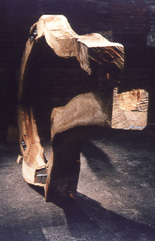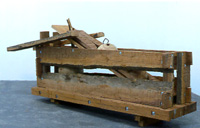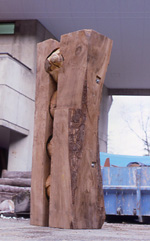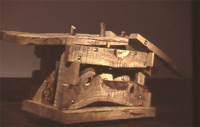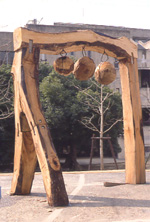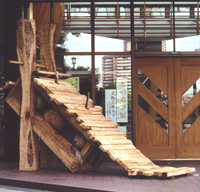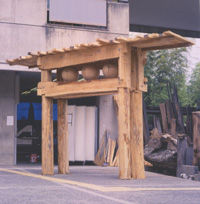 |
JITSUYA OZAKI Exhibition |
|||||||||||||||||||||||||||||||||||||||||||||||||||||||||||||||||||||||||||||||||||||||||||||||||||||||||||||||||||||||||||||||||||||||||||||||||||||||||||||||||||||||||||||||||||||
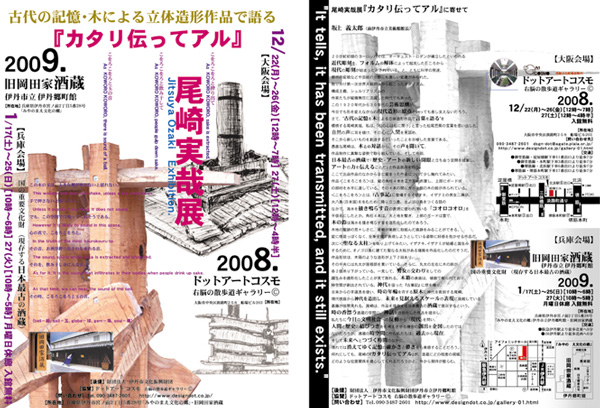 |
|||||||||||||||||||||||||||||||||||||||||||||||||||||||||||||||||||||||||||||||||||||||||||||||||||||||||||||||||||||||||||||||||||||||||||||||||||||||||||||||||||||||||||||||||||||
| "It tells, it has been transmitted, and it still exists."
As KOWORO KOWORO, sake is extracted. As KOWORO KOWORO, people gulp down sake. As KOWORO KOWORO, there is sound of a ball. "KOWORO KOWORO-to," This sound is a sound that rings when seawater is rolled and thrummed with a sacred spear "Ame-no-nuhoko " that appears in Kojiki . Afterwards, the island which comes down in order that Izanami Izanami's male-and-female two deities create the Ooyasima (Japan) by that cause, and the Onogoro Island were produced. This wooden bell does not shake, unless a big wind blows, Unless it pushes it by hand, it does not sound. However it is likely to sound in this space. In the truth of the mindノkourokouru-to. The sound, sound which saka is extracted and produced. As for it, it is the sound that infiltrates in their bodies when people drink up sake. At that time, we can hear the sound of the bell. (bell−鈴, ball−玉, globe−球, gem−珠, soul−魂) 1.Ame-no-nuhoko (heavenly jewelled spear) is the name given to the sacred spear in Japanese mythology used to raise the primordial land-mass, Onogoro-shima, from the sea. 2.Kojiki, the oldest records of ancient matters which still exists, a three-volume text with volume one recounting the Japanese of mythology, volume two depicting the reigns of Emperors Jinmu through Ojin, and volume three describing the reigns of Emperors Nintoku through Suiko. It was compiled by Hieda no Are and Ono Yasumaro in 712 for the Emperor Temmu. |
|||||||||||||||||||||||||||||||||||||||||||||||||||||||||||||||||||||||||||||||||||||||||||||||||||||||||||||||||||||||||||||||||||||||||||||||||||||||||||||||||||||||||||||||||||||
 |
|||||||||||||||||||||||||||||||||||||||||||||||||||||||||||||||||||||||||||||||||||||||||||||||||||||||||||||||||||||||||||||||||||||||||||||||||||||||||||||||||||||||||||||||||||||
| |||||||||||||||||||||||||||||||||||||||||||||||||||||||||||||||||||||||||||||||||||||||||||||||||||||||||||||||||||||||||||||||||||||||||||||||||||||||||||||||||||||||||||||||||||||
| 尾崎実哉展『カタリ伝ってアル』に寄せて | |||||||||||||||||||||||||||||||||||||||||||||||||||||||||||||||||||||||||||||||||||||||||||||||||||||||||||||||||||||||||||||||||||||||||||||||||||||||||||||||||||||||||||||||||||||
|
坂上 義太郎(前伊丹市立美術館館長) 20世紀初頭のヨーロッパでは、オーギュスト・ロダンが確立したといわれる 近代彫刻を、フォルムの解体によって超克したところから 現代の彫刻が始まったとされている。と、ともに科学の発達、 都市の変貌などや芸術の分野にも激しい変遷がみられた。 取り分け第一次世界大戦前後から起こったダダイズム、 構成主義、シュルリアリズムの 作家たちが縦横無尽に活躍した時代でもあった。 この1920年代から30年代の芸術思潮が、 今日でも形を変えながらの現代造形の原点といっても差し支えないだろう。 さて、"古代の記憶を木による立体造形作品で言葉を語る"を 標榜する尾崎実哉、私は、「松の心は松に聞け」と言った松尾芭蕉の言葉を思い出した。 自然の声に耳を傾け、その心に人間を見詰め、 そこから新しいものを創造するといったことを示唆した言葉である。 愚直な尾崎は、木との対話から、その声を聞いて、 作品制作に真摯な姿勢で取り組んでいる。そして今回、 日本最古の酒蔵で「歴史・アートの新しい開眼と立ち会う空間を提案し、 アートの力を伝えることだ」と作品展示を行う。 ここで出品作品のなかから目に留まった作品について少し触れてみたい。 作品 <こをろこをろ>は、縦の角柱4本を正方形に布置し、上部にボード状 の部材を水平に渡している。その4本の間に大小3個の木の鈴が吊られている。 <こをろこをろ>とは、『古事記』に登場するイザナキ、イザナミの男女二神が、 大八島(日本国)を生むために降り立つ島、オノゴロ島をつくる話の なかで、海水を掻き鳴らす音の表現に使われている「コオロコオロ」を 平仮名にしたとか。角柱4本は、天と地を繋ぎ、上部のボードは雲で、 木の鈴は海水を掻き鳴らす音を造形化したのであろう。 木地の鑿跡の荒々しさに、尾崎が果敢に取組んだ痕跡をみることができる。 変に理屈っぽくなく、全身全霊で表現しようとしている姿勢に好感を抱かせる作品だ。 次に<聖なる太柱>を取り上げてみたい。イザナキ、イザナミが結婚と国生み するために、オノゴロ島に建てた聖なる太柱がある寝殿を作品化したのだそうだ。 作品形状は、木箱のような造形が上下2段あり、 その中央には丸太が屋根部を貫いている。さらに、丸太の左右に木の鈴が 各2個吊り下がっている。一見して、男女の交わりをしての 国生みを造形化したことが見て取れる。木箱の表面は、槍鉋で削られており、 時空間が創出されている。神代を扱った『古事記』に想を練り、 古来からの手道具を使い、時の年輪を存する原木に神代を彫刻する尾崎。 現代視座から神代を造出し、未来を見据えるスケールの表現に挑戦している 葛藤が垣間見れる。尾崎は、作品を現存する日本最古の酒蔵で展示するという。 時の香漂う酒蔵の空間に、神話を造形化した作品を提示し、 私たちに今日の文明社会への反動から「現代」を問い、 人間と歴史の結びつきをも考えさせる機会の創出を企図したのでは ないだろうか。酒蔵の時空間に佇む私たちは、過去から現在、 そして未来へとつづく時間のなかに、 現れては消えてゆく記憶の確かさと儚さをも実感することだろう。 何れにしても、尾崎の『カタリ伝ってアル』が、酒蔵にどの程度の規模、 どのような位置関係を腐心してくれるだろうかと、今から期待が膨らむ。 |
|||||||||||||||||||||||||||||||||||||||||||||||||||||||||||||||||||||||||||||||||||||||||||||||||||||||||||||||||||||||||||||||||||||||||||||||||||||||||||||||||||||||||||||||||||||
| Theme: "It tells, it has been transmitted, and it still exists." | |||||||||||||||||||||||||||||||||||||||||||||||||||||||||||||||||||||||||||||||||||||||||||||||||||||||||||||||||||||||||||||||||||||||||||||||||||||||||||||||||||||||||||||||||||||
| He states the memory from our ancient times to the future by his wooden sculpture.
His wooden sculpture is based on ancient people's awe for nature. He has talked with logs and has expressed ourselves as his work through the remembrance from the antiquities. |
|||||||||||||||||||||||||||||||||||||||||||||||||||||||||||||||||||||||||||||||||||||||||||||||||||||||||||||||||||||||||||||||||||||||||||||||||||||||||||||||||||||||||||||||||||||
| Biography | |||||||||||||||||||||||||||||||||||||||||||||||||||||||||||||||||||||||||||||||||||||||||||||||||||||||||||||||||||||||||||||||||||||||||||||||||||||||||||||||||||||||||||||||||||||
|
|||||||||||||||||||||||||||||||||||||||||||||||||||||||||||||||||||||||||||||||||||||||||||||||||||||||||||||||||||||||||||||||||||||||||||||||||||||||||||||||||||||||||||||||||||||
| 展覧会風景 | |||||||||||||||||||||||||||||||||||||||||||||||||||||||||||||||||||||||||||||||||||||||||||||||||||||||||||||||||||||||||||||||||||||||||||||||||||||||||||||||||||||||||||||||||||||
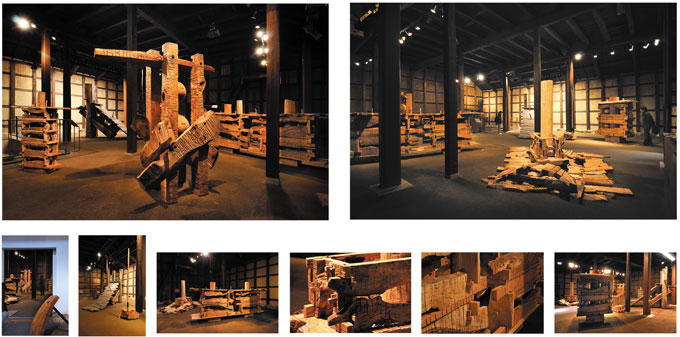 |
|||||||||||||||||||||||||||||||||||||||||||||||||||||||||||||||||||||||||||||||||||||||||||||||||||||||||||||||||||||||||||||||||||||||||||||||||||||||||||||||||||||||||||||||||||||
| ART | |||||||||||||||||||||||||||||||||||||||||||||||||||||||||||||||||||||||||||||||||||||||||||||||||||||||||||||||||||||||||||||||||||||||||||||||||||||||||||||||||||||||||||||||||||||
作品データは以下の順に記す。作品名/制作年/寸法(cm)/技法/素材 |
|||||||||||||||||||||||||||||||||||||||||||||||||||||||||||||||||||||||||||||||||||||||||||||||||||||||||||||||||||||||||||||||||||||||||||||||||||||||||||||||||||||||||||||||||||||
|
|
|||||||||||||||||||||||||||||||||||||||||||||||||||||||||||||||||||||||||||||||||||||||||||||||||||||||||||||||||||||||||||||||||||||||||||||||||||||||||||||||||||||||||||||||||||||
